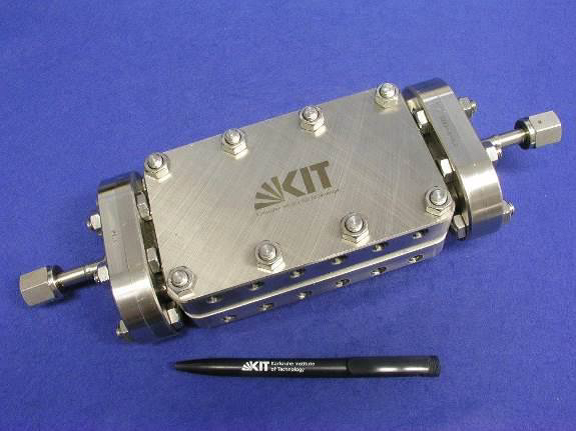3-step-hydration of nitrobenzene
- contact:
- Partner:
Karlsruhe Institute of Technology
Ruhr-Universität Bochum
TU Dresden
TU Hamburg-Harburg
Friedrich-Alexander-Universität Erlangen-Nürnberg
Fraunhofer-Institut IKTS Dresden
- startdate:
07/2012
- enddate:
06/2016
Project abstract
One of the aims in the work packages of IMVT was to build a microreactor to perform the three phase nitrobenzene hydrogenation under pressures up to 80 bar and temperatures up to 300°C. The attempt was to use the micro reaction technology to enable better heat utilization of the reaction by improvement of the mass and heat transfer properties. These properties could enable an isothermal operation of the highly exothermic nitrobenzene reaction in undiluted state and at higher temperature and pressure. In this circumstance, solubility measurements of hydrogen in aniline, nitrobenzene and water as well as their mixtures at temperatures above 200°C were needed to supply data for the modeling tasks.
The measurements of hydrogen solubility in nitrobenzene/aniline mixtures showed that hydrogen solubility in mixtures nitrobenzene/aniline decreased with decreasing temperature in the range of 30°C‒210°C and under pressure between 20 and 30 bar. Based on the results of experiments, the Henry’s constants as a function of temperature for pure nitrobenzene and aniline were experimentally determined and adequate correlations for the mixtures were proposed.
The project results gave further insights into possible reactor constructions including preliminary studies in a stirred batch reactor with gas entrainment impeller for calculations on gas->liquid->solid mass transport importance. A reactor concept with a coated channel is modelled under the assumption of an annular flow, which shows severe importance of the film thickness on mass transport in the liquid film. Due to low residence time and conversions under annular flow, a type of micro trickle bed reactor was developed to improve the residence time and the total volumetric catalyst amount during the project. Specific issues of pressure drop and catalyst movement have been solved. Finally, it was possible to show that conversions up to 88 % can be reached at 260°C and 10 bar, near isothermal conditions and pure nitrobenzene feed at 7.1 g·gcat-1·h-1. At 200°C, a pressure of 40 bar and slight hydrogen excess almost 100 % selectivity to aniline was possible.

Reactor for dehydrogenation of nitrobenzene at 300 °C and 80 bar
Publications:
[1] A. K. Mogalicherla, S. Lee, P. Pfeifer, R. Dittmeyer, Drop-on-demand inkjet printing of alumina nanoparticles in rectangular microchannels. Microfluidics and Nanofluidics, 16(2014) pp.655-666
[2] O. Görke, M. Cholewa, D. Semu, M. Kraut, P. Pfeifer, Three-Phase hydrogenation of nitrobenzene in microstructured reactor, submitted in Chem. Eng. Sci. (2018)
[3] O. Görke, M. Kraut, P. Sobieszuk, A. Srebniak, Measurements of hydrogen solubility in nitrobenzene/aniline mixtures, 22nd Polish Conference of Chemical and Process Engineering, 5.–9. 9. 2016, Spała, Poland.
[4] A. Srebniak, M. Kraut ; O. Görke; Sobieszuk, P.Measurements of hydrogen solubility in nitrobenzene/aniline mixtures, Chemical and process engineering 2017, 38 (2), 241-248
